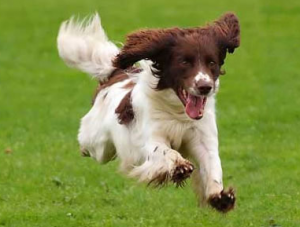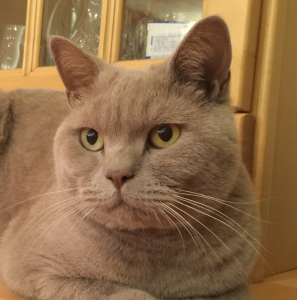News
Archive for April, 2016
CRUCIATE DISEASE IN DOGS
by admin on April 1st, 2016
Category: News, Tags: Tags: cruciate disease, dogs, highland terrier, labrador, mastiff, rottweiler

Injury or failure of the cranial cruciate ligament (commonly referred to as Cruciate Disease) is a very common problem that can be encountered by dogs of all shapes and sizes. Some breeds such as the Labrador Retriever, Rottweiler, Mastiff breeds and West Highland white terrier appear predisposed whereas some breeds such as greyhounds are seldom affected. Cruciate disease is the most common reason for orthopaedic surgery being performed and the most common reason for referral to a specialist orthopaedic surgeon being considered. Cruciate ligament rupture also occurs in cats but is far less common.
What are the cruciate ligaments?
Ligaments are tough bands of tissue situated in and around joints to provide stability whilst still permitting normal movement of the joint. There are two cruciate ligaments found within the stifle (knee) joint – the cranial cruciate ligament and the caudal cruciate ligament. The cranial cruciate ligament originates between the condyles (knuckles) of the femur and passes diagonally forwards and medially (towards the inside of the joint) to attach on the upper surface of the tibia. The caudal cruciate ligament sits behind the cranial cruciate ligament and passes in the opposite diagonal (from medial to lateral). When both cruciate ligaments are viewed from the front of the joint they form a cross or X shape, hence the name cruciate.
The cranial cruciate ligament is more important than the caudal cruciate ligament and is responsible for preventing three movements that may become apparent where the ligament fails:
- Tibial thrust – The tibia slides forwards in relation to the femur, leading to the sensation that the joint will not lock out when standing/walking.
- Internal tibial rotation –the tibia and lower limb pivot around the long axis of the bone. This may result is the paw turning inwards when the foot touches the floor, a so called pivot shift.
- Hyperextension – Some dogs will cause rupture the cruciate ligament by hyperextending the stifle joint. This most commonly happens where the hindlimb gets caught in a fence whilst jumping.
Why do cruciate ligaments become injured?
The majority of dogs develop rupture of the cruciate ligament as a consequence of a degenerative process where the fibres within the ligament gradually break down. The cause of this degeneration is unproven at this time. Ligament degeneration occurs with normal activity and can take many months. Owners frequently report intermittent periods of mild lameness that then seem to resolve spontaneously. Unfortunately the ligament is typically getting progressively weaker and eventually will rupture. Some dogs can be persistently lame with a partial tear of the cruciate ligament, where others will only become lame at the point of complete rupture.
A relatively small proportion of dogs will injure their cruciate ligament during a traumatic incident, such as where the limb is caught in a fence. If cruciate rupture has resulted from such an accident, there will often be other damaged ligaments that must be recognised and appropriately treated if limb function is to be restored.
How can you be sure that the cruciate ligament has failed?
The diagnosis of cruciate disease can be made based on clinical examination in the majority of cases. There is typically a hindlimb lameness that varies from mild to non-weight bearing. The affected stifle joint is often painful and distended with fluid. A pad of fibrous tissue called a medial buttress may develop on the medial side of the tibia in longstanding cases. The most important tests for cruciate rupture are the cranial drawer and tibial compression tests. These are performed by your veterinary surgeon and are tests of joint stability that aim to detect the tibia sliding forwards in relation to the femur. An abnormal degree of this movement indicates rupture of the cranial cruciate ligament. With recent complete ruptures, the instability is generally very obvious, however where there is a partial tear or a very longstanding cruciate rupture, the degree of instability can be virtually undetectable. Where this occurs assessment of the joint by MRI or by direct surgical assessment may be necessary to confirm the diagnosis.
What happens to the joint after a cruciate rupture?
Cruciate injury causes the release of pro-inflammatory substances within the joint. This inflammatory response causes a cycle of events that results in the inevitable and irreversible degeneration of articular cartilage that we know as osteoarthritis. As cartilage degenerates it becomes more fragile and susceptible to injury as a result of the abnormal shearing forces exerted on the now unstable joint.
The joint surfaces of the femur and tibia are separated by two fibrocartilage pads, each called a meniscus. Each meniscus is shaped like a flattened kidney bean and is fixed within the joint by other small ligaments. When considered as a unit, the two menisci form a shallow dish of fibrocartilage that act as a shock absorber to reduce the pressure exerted on the underlying cartilage. Following cruciate rupture, the medial meniscus frequently becomes damaged as a result of being crushed between the joint surfaces as the tibia shifts forwards underneath the femoral condyle. The damaged meniscus is painful and can become trapped between the joint surfaces, causing further damage to the joint surface. The recognition and treatment of meniscal injury is an important part of the surgical management of cruciate disease.
It is an unfortunate reality that degenerative cruciate disease often occurs simultaneously in both stifle joints. Approximately 60% of dogs sustain a cruciate rupture in the other stifle joint within 18 months of the first side failing. Occasionally we see dogs where both cruciate ligaments have ruptured simultaneously. This causes substantial problems walking as both hindlimbs are painful and it is not uncommon for the symptoms to be mistakenly attributed to a spinal cord injury.
Will my pet always be lame after a cruciate rupture has occurred?
It is possible to successfully manage almost all cases of cruciate rupture successfully. The best outcomes are most consistently found following surgical intervention to improve joint stability and treat meniscal injury. Some dogs will regain reasonable function without surgery, however in general most conservatively managed dogs will be persistently lame with varying degrees of muscle wastage, restricted range of motion and ongoing joint pain.
There are a multitude of surgical treatment options that may be applied to dogs and cats with cruciate disease. Part 2 of this article will discuss the various treatment options that are available.
April 2016 Tackling Ticks Offer
by admin on April 1st, 2016
Category: Special Offers, Tags:
Pet of the Month April 2016 – Winston!
by admin on April 1st, 2016
Category: Pet of the Month, Tags: Tags: cat, feline, vomiting, winston

Young Winston is featured this week as he has fortunately made a swift and complete recovery following treatment for vomiting using an extended course of antacids and a bland diet. Apart from showing off his good looks this article illustrates a common feline problem and the approach taken for pets whose response to treatment is not quite so immediate as his.
You’ve probably witnessed your cat vomiting from time to time without raising too much concern. Vomiting is a protective mechanism that can result from something minor such as overindulgence or access to an irritant, or it can be a sign of a much more serious condition associated with a primary gastrointestinal disorder (e.g. an ingested foreign body) or a systemic disorder (e.g. kidney disease).
What is the difference between your cat vomiting and and your cat regurgitating? Why does it matter?
The oesophagus is a narrow, muscular tube that allows food to pass through on its way to the stomach. In healthy cats, food will move quickly through the oesophagus to the stomach with little to no delay. When you take your cat to your veterinary surgeon because he or she is vomiting, they will ask you questions in attempt to differentiate between vomiting and regurgitation.
Regurgitation is the passive ejection of contents from the oesophagus. The cat will lower its head and food is expelled with little or no effort. The food is usually undigested, may have a tubular shape, and is often covered with a slimy mucus. Cats will also attempt to eat the regurgitated material.
If the muscle of the oesophagus is considered diseased, it will either result in widening of the oesophagus due to loss of muscular tone (called ‘megaoesophagus’), or narrowing of the oesophagus, which acts as an obstruction to material moving down into the stomach (e.g. a stricture, a tumour or a foreign body can all cause narrowing of the oesophagus). A dilated (widened) oesophagus will not effectively, or efficiently, move or push food from the oesophagus into the stomach. This delay can result in regurgitation shortly after eating. The danger of regurgitation is that the contents may also be inhaled into the airways causing pneumonia and a cough. It’s therefore important for your vet to differentiate between vomiting and regurgitation as this will have an impact on deciding which diagnostic tests to perform, and also will help when deciding on the most appropriate treatment options.
Vomiting, on the other hand, is an active process. Cats will often vocalise, be apprehensive and heave/retch to vomit. If food is present in vomit, it is partially digested and can also contain a yellow fluid (bile). Vomiting can be divided down into primary (gastrointestinal) causes, or secondary (non-gastrointestinal) causes.
Primary causes of vomiting are those diseases directly affecting the stomach and upper intestinal tract. Secondary causes are due to diseases lying outside of the gastrointestinal tract and can include neurological disease or accumulation of toxic substances in the blood. Neurological disease and/or toxic substances will stimulate the vomiting centre in the brain and cause the animal to vomit. Additionally, vomiting can be further divided into acute versus chronic causes.
Some common causes for sudden (acute) vomiting in cats include:
- Diet-related causes (diet change, food intolerance)
- Gastric or intestinal foreign bodies (eg. toys, hairballs, or where one part of the intestine moves inside another part of the intestine)
- Gastrointestinal parasites
- Urinary tract causes: acute kidney failure, ruptured bladder
- Acute liver failure
- Pancreatitis
- Ingestion of toxins or chemicals
- Viral infections
- Certain prescribed medications
- Inner ear/neurological disorders
- Decompensation of a more chronic disease
Some common causes for chronic vomiting in cats (vomiting greater than 3 weeks duration) include:
- Gastritis/gastroenteritis (infectious, toxic, dietary indiscretion/intolerance)
- Hyperthyroidism
- Inflammatory bowel disease (gastritis, enteritis, colitis)
- Severe constipation
- Diabetes (ketoacidosis – this is a form of uncontrolled diabetes)
- Chronic liver disease
- Chronic kidney disease
- Pancreatitis
- Cancer (gastric/intestinal)
- Inner ear diseases/neurological disorders
- Heart worm disease
What should I do if my cat vomits frequently?
An occasional, isolated bout of vomiting is normal. However, frequent vomiting can be a sign of a more serious condition. Your vet will normally ask you a very detailed clinical history and perform a thorough physical examination. This information can help your vet narrow down potential causes from the very long list of possibilities.
The presence of fever, abdominal pain, jaundice, anaemia or abnormal masses in the abdomen will help your vet make a more specific diagnosis. The mouth should be carefully examined as some foreign objects such as string can entangle themselves around the base of the tongue with the rest of the object extending into the stomach or small intestine. A nodule may be palpated in the neck of cats with hyperthyroidism.
Many times, a full physical examination may be normal and unremarkable. At this stage, your vet may choose to adopt trial treatment/supportive care by implementing a brief starvation period, with or without administration of fluid therapy and various medications (e.g. pain relief, anti-nausea medications, antacids) and assess your cat’s response.
Further investigation of vomiting in cats
Depending on response, your vet may need to perform further investigations to differentiate primary from secondary causes of vomiting. Depending on history, clinical examination, and response to trial therapy, further tests may be needed and may include blood tests, urine analysis and faecal examination to rule out possible toxicities, parasites, and metabolic diseases. Further blood tests may include FIV/FeLV (Feline Immunodeficiency Virus and Feline Leukaemia Virus) to assess viral status. Although FIV/FeLV are not common primary causes of vomiting, they may reflect underlying immunosuppression which may make the cat more susceptible to certain diseases. Your vet may also decide to perform tests to assess the pancreatic health (e.g. pancreatitis).
Depending on the case, your vet may then decide to proceed with ‘second tier’ testing. This usually would involve some diagnostic imaging – x-rays and ultrasound – which can be useful in identifying masses, foreign objects, and other gastrointestinal tract problems such as pancreatitis.
Finally, if indicated, further ‘third tier’ testing may be indicated to obtain a biopsy of intestinal tract tissue if cancer or inflammatory bowel disease is suspected. Biopsies can be collected using either minimally invasive procedures (endoscopy and/or laparoscopy) or more invasive procedures (exploratory laparotomy). Endoscopy (a small camera attached to a long flexible tube) is commonly used to visualise the inside of the oesophagus, stomach and first part of the small intestine and to obtain small biopsies called ‘pinch biopsies’. It may also be possible to provide therapeutic interventions with an endoscope. Laparotomy (open surgery) or laparoscopy (‘key hole surgery’) may be considered for those cases where samples of organs lying outside of the stomach/small intestine and full thickness biopsies of intestines are needed.
This information will help your vet to identify the cause, streamline a treatment plan, and also provide you with a prognosis.
What are some treatment options?
The treatment for vomiting depends upon the underlying cause.
Non-specific treatment may include a 12-24 hour fasting period. Fluids may need to be withheld for a short period of time until vomiting has ceased. Water should never be withheld from an animal with known or suspected kidney disease without replacing fluids intravenously or subcutaneously (under the skin).
Water can be reintroduced in small volumes after a 6-12 hour period. You may wish to start with tuna water (not brine) or chicken broth (with NO added onion/garlic or powders) to encourage fluid intake. Gradual increases in volume may commence over the course of the day if vomiting does not recur.
Provided oral fluids have been well-tolerated, small volumes of a bland, high quality protein source (boiled chicken breast, tuna in spring water, turkey breast, boiled white fish) may then be introduced. It’s advisable to start with a teaspoon size portion every 4-6 hours for 1-2 days. Again, if tolerated, gradual increases in food volume may be attempted with the aim to wean back to the original diet over a 3-5 day period. If a cat is bright and alert and has had no previous health problems, episodes of acute vomiting may be managed at home, although veterinary consultation prior to home treatment is strongly advised. In certain situations (e.g. depression, dehydration, or symptoms lasting longer than 12-24 hours), your cat may require fluid therapy or drugs to help control vomiting. You’ll need to see your vet to determine the proper course of action.
What other symptoms should I watch for?
The causes of vomiting are so varied and can be extremely difficult to accurately diagnose. It’s therefore important to monitor for other signs of ill health that may help direct your vet in his/her quest in identifying the underlying cause.
What to watch for:
- Frequency of vomiting. If your cat vomits once and proceeds to eat regularly and have a normal bowel movement, the vomiting was most likely an isolated incident
- Diarrhoea
- Dehydration (sticky gums, weak, sunken eyes, increased ‘skin tenting’)
- Lethargy
- Blood in vomit
- Weight loss
- Change in appetite and water intake (either increased or decreased)
When is it time to see the vet?
Please see your vet if you notice any of the symptoms mentioned above or if vomiting persists. Depending on your cat’s age, medical history, physical examination findings and particular symptoms, your vet may choose to perform various tests and/or admit your cat for more intensive treatment.


